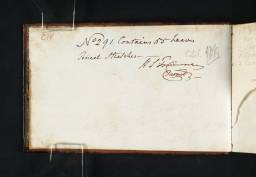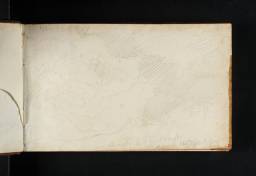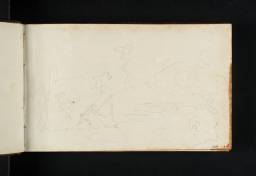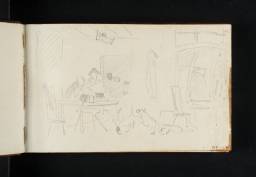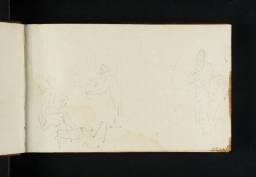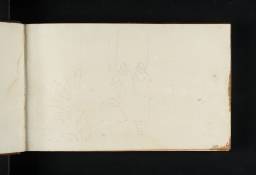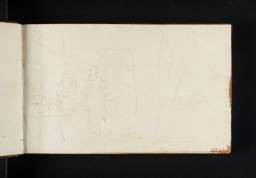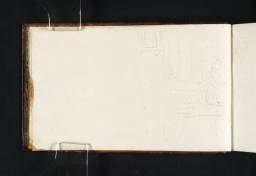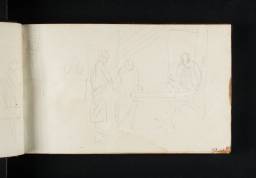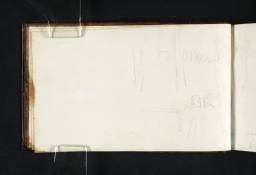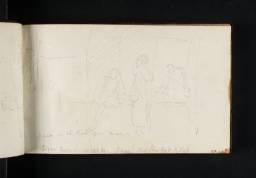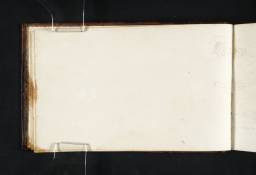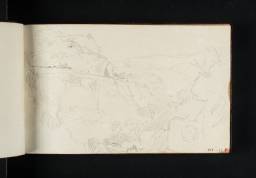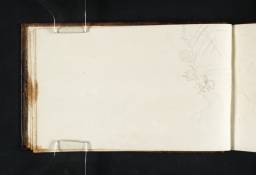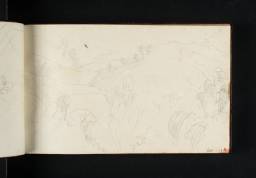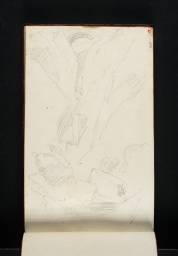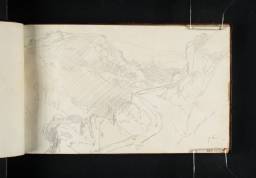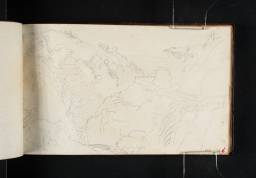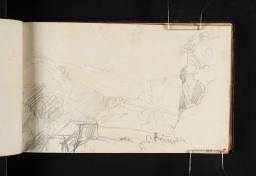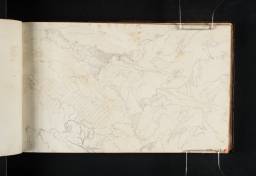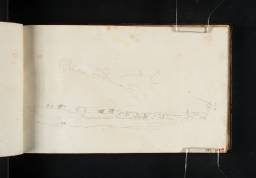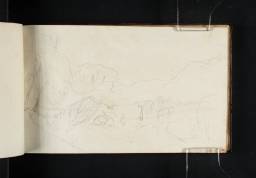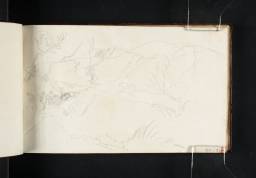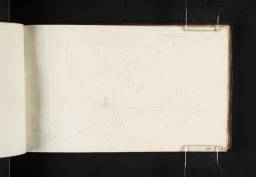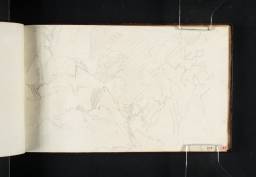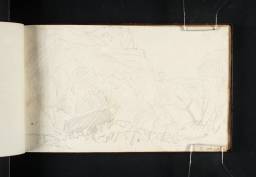Turner Bequest CIV
Pocket book, bound in calf with gold tooling on covers and spine and endpapers of green, black and buff marbled paper
89 leaves of white laid paper
Approximate page size, 98 x 162mm.
Made by T.W. and B. Botfield at Hopton Wafers Mill, Shropshire
Inscribed by Turner in ink ‘28. Tabley’ (now removed)
Endorsed by the Executors of the Turner Bequest in ink ‘No291. Contains 55 Leaves | Pencil sketches’ and signed by Henry Scott Trimmer and Charles Turner in ink ‘H.S. Trimmer’ and ‘C Turner’ and by Charles Lock Eastlake and John Prescott Knight in pencil ‘C.L.E.’ and ‘JPK’ on folio 1 verso (D40805)
89 leaves of white laid paper
Approximate page size, 98 x 162mm.
Made by T.W. and B. Botfield at Hopton Wafers Mill, Shropshire
Inscribed by Turner in ink ‘28. Tabley’ (now removed)
Endorsed by the Executors of the Turner Bequest in ink ‘No291. Contains 55 Leaves | Pencil sketches’ and signed by Henry Scott Trimmer and Charles Turner in ink ‘H.S. Trimmer’ and ‘C Turner’ and by Charles Lock Eastlake and John Prescott Knight in pencil ‘C.L.E.’ and ‘JPK’ on folio 1 verso (D40805)
Accepted by the nation as part of the Turner Bequest 1856
References
This is the second of three sketchbooks associated with Turner’s visit to Sir John Leicester at Tabley House, Cheshire, in the summer of 1808. It was used on an expedition into North Wales, probably from Tabley. There are views of Llangollen, Corwen and further along the Dee Valley. Pictures were painted from sketches in this book.
The other sketchbooks used at Tabley are Tabley No.1 and Tabley No.3 (Tate D06830–D06857; D40065; D40720–D40721; Turner Bequest CIII and Tate D06984–D07126; D07128–D07131; D40628–D40630; D40638; Turner Bequest CV). Finberg commented that despite Turner’s label ‘Tabley’, Tabley No.2 ‘does not appear to contain any sketches of Tabley House’. While this is strictly true, folios 87 and verso and 88 verso (D06979, D06980, D06982; Turner Bequest CIV 86, 86a, 87a) have what seem to be ideas for a bridge and tower in different styles, one tower being clearly that in the lake or Moat at Tabley which Turner painted in his two views of the house and estate.1 In these pictures, Turner shows a low bridge in the left distance which may be based on one leading to the island where Tabley Old Hall stood, but could also be an invention; perhaps Turner was indulging his fancy as an amateur architect. Finberg himself drew attention to a further drawing, on folio 71 verso (Turner Bequest CIV 70a), of wooded scenery and an inscription that he read as ‘Up Tabley (?)’. Conceivably this could be the wooded road towards Tabley from Knutsford, while Turner’s note might refer to Over Tabley nearby.
The majority of the identifiable subjects in the book are from Turner’s trip to Wales. They are concentrated on the River Dee, the Vale of Llangollen and Corwen before continuing south-west towards Bala and Llyn Tegid where Sir Richard Colt Hoare had a summer residence. For Hoare’s friendship with Sir John Leicester, his movements in 1808 and the possibility that these might have coincided in part with Turner’s or with a visit by Sir John to Hoare, see Introduction to Tabley No.1. Folio 15 of the present book (D06876; Turner Bequest CIV 14) depicts a small coach-party halting; the vehicle seems lighter than a public mail or passenger coach. Painter and patrons were all keen fishermen and the attractions of river and lake are evident as early as folio 4 (D06860; Turner Bequest CIV 3) where a man (rather unfairly described by Finberg as a ‘grotesque figure’) is seen fly fishing. A list of items to take on tour, on folio 5 verso (D06862; Turner Bequest CIV 4a), includes a fishing rod and on folio 55 verso (D06930; Turner Bequest CIV 54a) Turner notes ‘Large Eel Hooks’ alongside a sketch of the same. Folio 29 verso (D06893; Turner Bequest CIV 28a) has a sketch that served as the basis of Trout Fishing in the Dee, Corwen Bridge and Cottage (Taft Museum, Cincinnati, Ohio).2 There are other related drawings of the Dee at Corwen on folios 45 verso and 46 verso–47 (D06914, D06916–D06917; Turner Bequest CIV 44a, 45a, 46). Trout Fishing may have been begun at Tabley after Turner returned from Wales; it is usually thought to have been the picture that Henry Thomson reported being started there, in addition to Turner’s views of Tabley itself, even though he also claimed that Turner spent most of his time fishing. For another candidate for a picture painted at Tabley, see below.
Concentrated towards the back of the sketchbook are a number of views of Llangollen, which was popular with scenic tourists. Turner’s drawings are made with the book inverted, suggesting that he was working from the back at this stage. Near the front, beginning on folio 5 (D06861; Turner Bequest CIV 4), are various sketches of figures and interiors, perhaps at an inn. Unless he made a circular tour, Turner would have passed through Llangollen twice, on his outward and return journeys, and the order in which he made his drawings is unclear. Views of Corwen are mainly in the middle of the book, preceded by a group made on the road between the town and Betws-y-Coed. This took him away from the Dee, but was a destination in itself. His drawings show that Turner was particularly struck by the road towards Ty-nant, where it zig-zagged between high projecting rocks and a steep drop; from here there were views over the gorge of the River Ceirw, Glyn Diffwys, and of a single-arched bridge, Pont-y-Glyn (Pont Glyn-Diffwys) which carried a track branching off from the main road. The area, then a celebrated beauty spot, is a kind of Switzerland-in-miniature and to judge from his drawings, Turner was reminded of the St Gotthard Pass and Devil’s Bridge that he had seen in 1802. He clambered down to the river bed and made a sketch looking up at the bridge, rather exaggerating its height for effect (folio 14, D06875; Turner Bequest CIV 13). Today this stretch of the road, which was later improved by Thomas Telford as part of his London–Holyhead route, is by-passed by the A5 but it is still possible to walk along it, and drive across Pont-y-Glyn. However, Turner’s views can no longer be fully appreciated as the gorge is overgrown with trees.
If Turner was on his way to Bala, this stretch of road would have been a diversion; he would have turned back to Corwen, probably rejoining the Dee and taking the road via Llandrillo, the most direct route to the east bank of the lake where Hoare’s house stood. Unfortunately, there are still a number of unidentified subjects in this sketchbook and none to confirm this route. Whether the book contains drawings from the later stages of this 1808 tour, which extended to Lancashire and Yorkshire, also cannot be confirmed. Among the most tantalising drawings in the book are several depicting a wide river or estuary with a barge laden with cargo, and cattle and figures at the water’s edge. Did Turner continue as far as the Welsh coast, perhaps from Bala to Dolgellau and towards the Mawddach Estuary and Barmouth? Folio 48 verso (D06920; Turner Bequest CIV 47a) especially was used for another picture, River Scene with Cattle (Tate N01857),3 thought to have been perhaps exhibited, as Trout Fishing certainly was, at Turner’s Gallery in 1809. If the latter was begun at Tabley, it did not stay there and was bought, presumably from the 1809 exhibition, by the Earl of Essex. The River Scene, on the other hand, appears in a watercolour of the Picture Gallery at Tabley by John Chessell Buckler, dated 1809 (Tabley House). It is shown hanging to the left of the chimneypiece. Although the Tate picture has no known provenance outside the Turner Bequest and does not seem to be otherwise documented in Sir John Leicester’s collection, Buckler cannot have invented its presence at Tabley in 1809 and his evidence makes its exhibition in London that year less likely. The most obvious explanation would be that this picture was painted or begun at Tabley and that Turner simply left it behind there. Sir John might have had it on approval or borrowed it to fill a temporary gap on his wall, before returning it later on.
Folios 53 verso, 54 and 86 verso (D06927, D06928, D06978; Turner Bequest 52a, 53, 85a) are ruled for music and connected with Turner’s flute or recorder playing. Similar notations, of diatonic scales and four-bar melodies are in the Tabley No.3 sketchbook. Khatchick Pilikian identifies them as ‘touch tables’ or fingerings for flute or recorder. Perhaps Turner performed at Tabley; a flute in the plasterwork by Thomas Archer on the ceiling of the Octagon, formerly the Common Parlour, and a virginal and spinet still in the house indicate the Leicesters’ musical interests.
Also of note is Turner’s description on folio 89 (D06983; Turner Bequest CIV 88) of reflections on a ‘white Body’ floating past him in the Dee, presumably while he was fishing. A longer passage on reflections in water is in Tabley No.3 (D07114, D40630). Turner was now collecting material for his lectures as Professor of Perspective at the Royal Academy. Lecture 5, first given in 1811, was devoted to ‘Reflexes’ and included observations on reflections in water and objects in it.
Tabley, Cheshire, the Seat of Sir J.F. Leicester, Bart.: Calm Morning (Tate T03878; displayed at Petworth House); Butlin and Joll 1984, pp.70–1 no.99 (pl.107): Tabley, the Seat of Sir J.F. Leicester, Bart.: Windy Day (Tabley House Collection, University of Manchester ); ibid., p.70 no.98 (pl.106).
Technical notes
How to cite
David Blayney Brown, ‘Tabley No.2 sketchbook c.1808’, sketchbook, May 2010, in David Blayney Brown (ed.), J.M.W. Turner: Sketchbooks, Drawings and Watercolours, Tate Research Publication, December 2012, https://www

